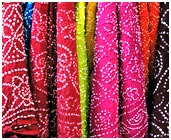Read about bandhani /bandhni, which’s ancient art of printing fabric by tie & dye method in Indian states of Rajasthan and Gujarat.
Bandhani
Bandhani can be described as the method of dyeing fabrics into vibrant hues, which is mainly popular in the Indian states of Rajasthan and Gujarat. In fact, in both of these states, the art of bandhani supports a strong handicraft industry. The name 'bandhani' (or bandhni) has been derived from the Hindi word ‘bandhan’, which connotes tying up. In accordance with the meaning of its name, bandhni basically involves tying and dyeing of fabrics, which are, more often that not, cotton or silk. Though, in the past, Bandhani print dresses have been worn only by ladies, nowadays, one will find it being used on the attires of men as well.

Popularly known as 'Khombi', 'Ghar Chola', 'Patori' as well as 'Chandrokhani', bandhani art work is mainly undertaken in the cities of Jaipur, Udaipur, Bikaner, Ajmer and Jamnagar. Here, you will mainly find odhnis, saris and turbans in bandhani, at times even bed sheets. Bandhani was initially started by the women in the Muslim Khatri Community of Kutchh. They passed on the art form as well as the tradition from one generation to the other, in turn becoming its concierge. With the passing time, a wide variety has evolved in bandhni, one of reasons being its close association with the religious and social customs of people.
Colors & Patterns
With colors like red, yellow, green, blue, orange, black and pink amply employed during the tie and dye process of the bandhni, the finished products always don a very bright look. It is common for bandhani fabrics to have a base of black or red color. In effect, the use of light hues is deliberately avoided in the work. The processing work is done in such a way that after its completion, the bandhani cloth bears symbols like dots, squares, waves and strips. As to the dye used in the process, the artists prefer sticking to natural ones.
Technique
You will find both men as well as women involved in the procedure of making bandhani clothes. While men concern themselves with the dyeing part, the women are concerned with tying. During bandhani printing, the cloth is covered with many tiny knots. The placement of these knots is crucial and pre-decided by the printer, as it is these knots only that later form the design, after the fabric is opened. As the first step for making bandhani, the cloth is washed and bleached. This is done with the aim of preparing the fabric for absorbing the dyes.
After the bleaching is complete, the fabric is sent to the bandhani i.e. the woman who does the tying work. She picks up a small portion of the fabric, at a time, and firmly ties a thread around it. Thereafter, the fabric is dyed. In case two shades are required in the fabric, it is dipped in the light color first. Following this, the areas in which the first dye has to be retained are tied, for resist. Finally, the fabric is dipped in a darker dye. In case, the fabric has to have a number of colors, the dying process is repeated as many times.


See also
More from iloveindia.com
- Home Remedies | Ayurveda | Vastu | Yoga | Feng Shui | Tattoos | Fitness | Garden | Nutrition | Parenting | Bikes | Cars | Baby Care | Indian Weddings | Festivals | Party ideas | Horoscope 2015 | Pets | Finance | Figures of Speech | Hotels in India : Delhi | Hyderabad | Chennai | Mumbai | Kolkata | Bangalore | Ahmedabad | Jaipur
- Contact Us Careers Disclaimer Privacy Policy Advertise With Us Lifestyle Sitemap Copyright iloveindia.com. All Rights Reserved.


